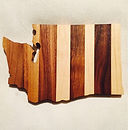End Grain vs Edge Grain Cutting Boards
What is the difference?
Everything you need to know about the two most popular types of hardwood cutting board designs.
Edge Grain Cutting Boards
How They're Constructed:
-
Various strips of hardwood are laminated (glued) together with their edge or face grain as the top surface (see figure below). Arranging the wood in this way allows for the figure in the wood to be seen as the cutting surface.
Design Features:
-
Easy to handle, clean
-
Natural grain detail
-
Affordable
-
Easy to refinish
-
Can be cut into fun shapes
Drawbacks:
-
Knife marks more apparent
Overall Review:
Edge or face grain boards are a great choice for any household, a chef on a budget, or a restaurant desiring to enhance their tableware. Continuous use of these boards will leave scratches in the surface, but they can easily be re-sanded and re-finished if significant knife marks become present. If these boards are well taken care of, they will last year after year.
End Grain Butcher Blocks
How They're Constructed:
-
Edge-grain planks are cut into strips as wide as the end-grain board is going to be thick. The pieces are then turned up on end and laminated together so that the end grain is now the cutting surface (see figure below).
Design Features:
-
Sturdiest design
-
Grain wedding and patterning create beautiful aesthetic
-
Best for knives
-
Knife marks less apparent
Drawbacks:
-
Most expensive
Overall Review:
If you have a bigger budget for your kitchen gadgets, investing in an end-grain butcher block is highly recommended. With end-grain cutting boards, your knives will stay sharper longer and cut marks are less apparent. End grain cutting boards are often considered pieces of artwork due to their beautiful patterning and grain wedding detials.







